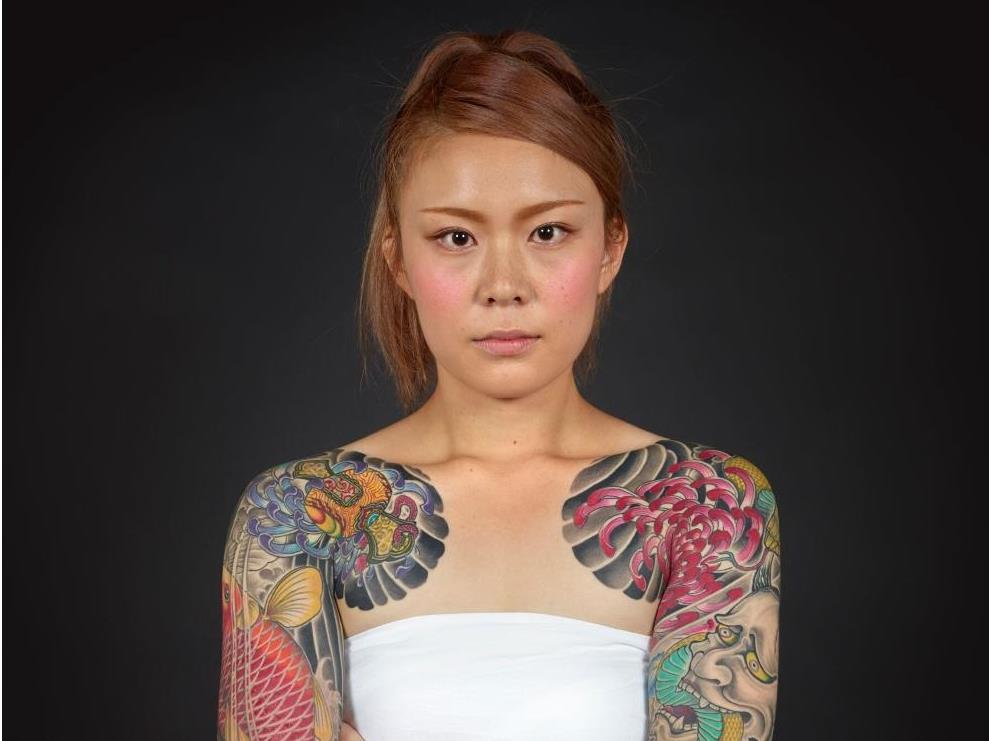Image: The work of tattooist Horikiku is on display at Our Bodies, Our Voices, Our Marks, as part of Perseverance: Japanese Tattoo Tradition in a Modern World. Photo: Kip Fulbeck.
When curator Takahiro Kitamura and photographer Kip Fulbeck’s proposal for Perseverance: Japanese Tattoo Tradition in a Modern World was first presented to the Japanese American National Museum, the idea was so controversial that seven staff members threatened to quit if the exhibition went ahead.
Fulbeck articulates the initial stages of planning such an exhibition: ‘Dr Greg Kimura, who was the president of the Japanese American National Museum, contacted me and said: “I want to do this show, but it’s going to be a bit controversial,” because in Japan and much of the Japanese community outside expats, tattooing is still quite forbidden,’ Fulbeck said.
The show, which features the work of seven highly acclaimed tattoo artists – Horitaka, Horitomo, Horishiki, Miyazo, Shige, Junii and Yokohama Horiken – and others eventually went ahead and broke every attendance record. It’s now landed at Melbourne’s Immigration Museum where it’s showing as part of the new exhibition Our Bodies, Our Voices, Our Marks, which includes a suite of exhibitions and experiences exploring the art of tattoo, alongside themes of identity, self-expression, culture and community.
Although tattooing is largely seen as an underground activity in Japan, it has persevered and is now internationally renowned for its artistry, lineage, historic symbolism and the skill of its practitioners.
Facing negative stigma due to its association with the yakuza (the Japanese mafia), tattoos in Japan are still very much taboo and the exhibition examines the beautiful artistry of the tattooists who have worked on Japanese subjects bold enough to get inked.
It’s Fulbeck’s hope that the work displayed in Perseverance will change the perception of Japanese tattooing to one that is synonymous with ancient Japanese artwork.
‘I think the main goal we’re trying to get at here is to show tattooing as a vibrant artform as much as any of the other artforms that emerged from the Edo period in Japan,’ he said.
‘So if I show you the famous Hokusai woodblock print The Great Wave off Kanagawa you’d recognise the artwork, because the woodblock print came from the same era as tattooing; the same culture, mythology, religious motifs, calligraphy and kabuki theatre – all these Japanese artforms are revered everywhere and so is tattooing, except in Japan.
‘We wanted to show how much this influence has gone on to impact clothing and skateboard design and different types of artwork.’
Artwork and influence
The strong influence of ukiyo-e woodblock prints is very much evident in the artwork on display.
‘There’s a very famous book that informed everything called the 108 heroes of the Suikoden,’ Fulbeck said. ‘It was a Chinese story very much like a Robin Hood, about these brigands that would steal from the rich to protect the poor. And in the woodblock prints the bandits were often pictured with full tattoos.’
Artist Chris [Horishiki] whose tattoos features in Perseverance, has re-interpreted the famous images from Suikoden to draw parallels with the culture between Japan and Los Angeles, using symbols and flora that are often outside of Japanese tattooing tradition
‘Chris’s piece is based on a woodblock print so if you look at the print, it’s exactly the same shape but instead of holding a sword, he’s [the warrior] holding a crowbar; instead of chrysanthemums, they’re roses; but it’s still very Japanese,’ Fulbeck said.
Horishiki has previously said of his work: ‘I found that many of the themes that the Japanese so readily accepted and related to were easily applicable and similar to Chicano history and Chicano tattoo culture. I also feel there is a strong connection between Japan and the West Coast of the United States.’
Tattooing is also significant in many other cultures including those of Aotearoa (New Zealand) where the art of marking skin has sacred meanings. The National Gallery of Australia’s current exhibition Māori Markings: Tā Moko explores the Māori art and its connecting patterns that tell of prestige, authority and identity, from its origin in the legend of Mataora and Niwareka and the earliest European records of the practice, to its contemporary resurgence from the 1990s.
‘In the 21st century, body adornment and marking has been embraced by many cultures and heavily influenced by Māori art,’ said National Gallery Director Nick Mitzevich. ‘An exhibition celebrating Māori art and culture is long overdue in Australia with an estimated one-fifth of today’s Māori population living here. In the International Year of Indigenous Languages this exhibition invites visitors to learn more about the First Nations cultures of our region.’
Disconnecting from reality
The work on display in Perseverance is as much about endurance and the physical demands placed on the body while being tattooed, as it is about aesthetics.
‘I don’t think it’s that far away from people who want to go to a yoga retreat …’ Kip Fulbeck
Fulbeck believes people are looking for an experience that awakens them, one that is far removed from the consumption of social media and reality television.
‘We have no connectivity with people, we live in digital worlds, so I think the idea of actually going through this process of something which is so tactile and visceral and present is something really important,’ Fulbeck said.
‘I don’t think it’s that far away from people who want to go to a yoga retreat or who want to go to a Zen silence retreat, or people who go on an endurance race; the idea is we’re trying to get in touch with our physicality, our presence on this earth again. I think these things bring us back from our screens.’
Perseverance Japanese Tattoo Tradition in a Modern World, is showing at the Immigration Museum until 6 October 2019.
Maori Markings: Tā Moko is showing at the National Gallery of Australia until 25 August 2019.





